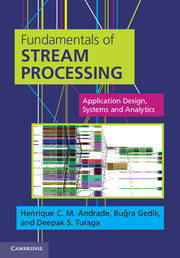Book contents
- Frontmatter
- Dedication
- Contents
- Preface
- Foreword
- Acknowledgements
- List of acronyms
- Part 1 Fundamentals
- Part II Application development
- 3 Application development – the basics
- 4 Application development – data flow programming
- 5 Large-scale development – modularity, extensibility, and distribution
- 6 Visualization and debugging
- Part III System architecture
- Part IV Application design and analytics
- Part V Case studies
- Part VI Closing notes
- Keywords and identifiers index
- Index
- References
3 - Application development – the basics
from Part II - Application development
Published online by Cambridge University Press: 05 March 2014
- Frontmatter
- Dedication
- Contents
- Preface
- Foreword
- Acknowledgements
- List of acronyms
- Part 1 Fundamentals
- Part II Application development
- 3 Application development – the basics
- 4 Application development – data flow programming
- 5 Large-scale development – modularity, extensibility, and distribution
- 6 Visualization and debugging
- Part III System architecture
- Part IV Application design and analytics
- Part V Case studies
- Part VI Closing notes
- Keywords and identifiers index
- Index
- References
Summary
Overview
In this chapter we introduce the fundamentals of application development using the stream processing paradigm. It is organized as follows. In Section 3.2, we provide an overview of the main characteristics of Stream Processing Applications (SPAs), focusing on how they affect the development process. In Section 3.3, we review the existing stream processing languages, deepening the discussion started in Chapter 2. In Section 3.4, we provide an introduction to the SPL language which will allow the readers to follow the examples provided in the rest of the book. In Section 3.5,weprovidealist of commonly used stream processing operators and discuss their roles by looking into their implementation as provided by the SPL standard toolkit.
From this point onwards, we will pair the technical exposition with actual code examples. These examples are provided using the Streams platform and the SPL language. We encourage the readers to try them out and to modify them as they go along.
Characteristics of SPAs
We first look at the characteristics of SPAs and discuss their impact on application development. These characteristics not only influence their design and implementation, but also permeate the design of the programming model and of the application runtime features provided by SPSs.
Data-in-motion analytics
SPAs implement data-in-motion analytics. These analytics ingest data from live, streaming sources and perform their processing as the data flows through the application.
Information
- Type
- Chapter
- Information
- Fundamentals of Stream ProcessingApplication Design, Systems, and Analytics, pp. 77 - 105Publisher: Cambridge University PressPrint publication year: 2014
